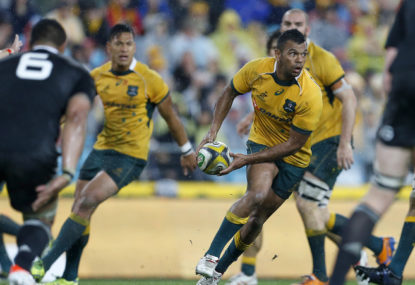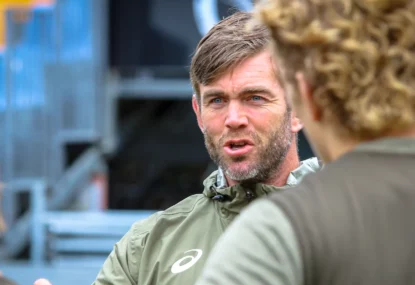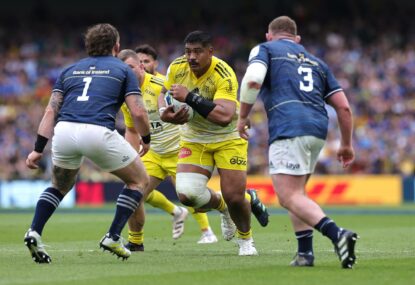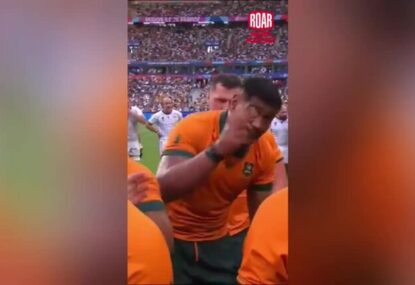The Wallabies well and truly dispatched England on Saturday, winning in a way that we are unaccustomed to seeing from an Australian team. A hugely dominant forward performance set the tone from the first tackle, and the team adjusted well to the shifting nature of the game.
While the win was far from perfect, a lot of the elements of Michael Cheika’s side seem to be slotting into place. Even as the execution dropped and England threatened to come back over the top in the middle of the second half, at no point did Australia look rattled and lose their composure. The method in the madness is starting to shine through.
Re-organisation, adaptation and the second (third, maybe fourth?) coming of Kurtley Beale
Rob Horne’s early injury should have had more of an influence. Ten minutes into the game with the scores locked, England turning the screws in their attacking half, and Australia’s key defensive cog was led remorsefully off the field, his arm in his shirt.
As the nation took a collective early morning breath, Beale came onto the left wing and turned in one of his most rounded performances. His revered attacking instincts were there – only once overplaying his hand with a speculative chip kick.
More impressively, one of the team’s most maligned defensive players produced consistently excellent tackles. Twice he made the quick and correct decision to cover a poor read from Tevita Kuridrani inside him and shut down an overlap.
The one blemish was that he and Bernard Foley should have connected with Anthony Watson as he held his line to score England’s try. One of the positive side-effects of the constant juggling of the back-line earlier this year appears to be an ease of adaptability in these situations. Australia finished with four possible No.10s on the field and didn’t look troubled by it at all.
9-10-12
The debate around the Wallabies’ best midfield combination is simply over. Foley played a near perfect 40 minutes and his best game in a gold jersey. He excelled impressively in his perceived failings, taking on the line, activating and directing his back-line, and kicking with aplomb.
Foley’s first four kicks from hand were special ‘ball on a string’ sort of stuff, as he continually put the English defence on the back foot. He was also the key man in each Australian try.
Firstly, playing with patience as pressure built through the phases (even without constant front-foot ball) before he launched his right-side attack, and secondly with a perfectly executed set move off a lineout (which was almost effective again in the 65th minute). Then there he was at the end, swooping around from his defensive position on the left wing to launch the final counterattack.
The man on the end of that counterattack, Matt Giteau, showed all the hallmarks of a player with 13 years of top level experience, bringing direction to the Australian midfield. Numerous times as play broke down Giteau tucked the ball under his arm and got the legs pumping, driving straight forward to set up cleanly and settle the attack.
Horne’s departure saw Giteau defending mostly at No.10, which he did effectively and intelligently. He was still making it count in the 60th minute, completing consecutive tackles in the middle of the field, the second of which led to a momentum-changing turnover for Michael Hooper.
Will Genia controlled the team well, even if he still showed his tendency to slow the attack down as he reorganises. This is looking to become the exception rather than the rule, and by and large Genia mixed his options and pace well – no more evident than in the eleven-phase build-up to the first try.
Two failed box kicks were the biggest blemish on his night. Despite having set alternatives in each instance, Genia twice allowed England to charge the ball down because he slowed delivery and telegraphed his intentions. On his third attempt just before he left the field Genia executed well, scanning the defence as he approached the ruck and acting immediately. He moved far enough from the ruck backwards and across to avoid a charge down with a well placed settling kick.
Nick Phipps for his part threw one errant pass early, followed immediately by a pass that sailed through five forwards in midfield, of which three moved out of the way to avoid touching the ball. Phipps looks unlikely to start, but like Dean Mumm, Ben McCalman and Matt Toomua is serving a very specific purpose for Australia late in the game as they change the shape and pace of the team in attack and defence.
The big men
The case of Kuridrani and Israel Folau’s quiet form is a curious one. Neither of them has done anything particularly wrong this year, but they haven’t shown the form that has made them world-class players over the last few years.
Folau looked flat throughout against England, two early errors directly cost Australia tries. A misread on Mike Brown prevented Horne from scoring after only four minutes, but more worryingly was seeing him losing the battle for the ball in the air four times, and not really look as though he was in the contest on any of them.
Folau still played effectively, beating tackles and bending the line, but he was short of the pace and Australia will be hoping his ankle injury doesn’t continue to hamper him.
Kuridrani is currently lacking the attacking penetration that saw him first elevated into the team, combined with some poor defensive reads in the middle of the field. Folau and Kuridrani were arguably more culpable on England’s try than Beale or Foley.
Kurindrani sat too tight in the line, giving George Ford a kink to run to before unloading to Joe Launchbury. Folau didn’t trust Beale’s drift and came in from the wing to crunch him, creating a mismatch on the outside as Beale and Foley had to tackle at full pace to try and cover.
It’s not panic stations yet, however you’d think Cheika and Stephen Larkham are doing some heavy thinking about how to get the most out of their two most potent running threats.
Man of the match
Lastly, much has been made about Launchbury’s gong for man of the match. In a beaten English team he was solid, but not even necessarily their best. There is a case, however, that the Twitter selectors were looking at a different set of criterion than bare statistics and results.
Launchbury had a key hand in the first three tries of the night, throwing a good quick pass under pressure to send Watson away, but also making the key error for both of Foley’s efforts. As Australian fans know by now, it can be very hard to know what’s going on at the selection table, but maybe there was a bigger picture at play on this one.



































































































